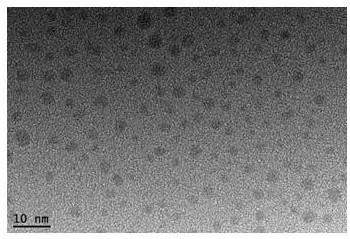Synthesis method of chiral copper sulfide superparticles
A synthetic method, copper sulfide technology, applied in the field of nanomaterials and self-assembly science, can solve the problem that chirality generates chiral signals and the interaction between chiral substances is poorly understood
- Summary
- Abstract
- Description
- Claims
- Application Information
AI Technical Summary
Problems solved by technology
Method used
Image
Examples
Embodiment 1
[0021] Example 1 The synthesis and purification route of penicillamine-stabilized chiral cuprous sulfide nanoparticles is as follows:
[0022] (1) Synthesis of penicillamine-stabilized chiral cuprous sulfide nanoparticles: under argon, 50 mL of ultrapure water was first heated to 60 °C and maintained for 30 min to exclude oxygen, and then 0.67 mmol of Copper chloride dihydrate (CuCl 2 2H 2 O), after it is completely dissolved, add 0.83 mmol of sodium hydroxide (NaOH), and stir evenly. 0.83 mmol of sodium borohydride (NaBH 4 ), after the color of the solution turns purple, add 0.67 mmol of penicillamine (Pen) at the end, and the solution slowly turns brown. After the temperature rises steadily to 95°C and stirs for 30 minutes under reflux, slowly cool to room temperature, and continue to react overnight , when the solution turns purple again, the reaction is complete.
[0023] (2) Purification of nanoclusters: Add 6 times more volume of isopropanol solution, centrifuge at 1...
Embodiment 2
[0025] Example 2 The method of assembling chiral copper sulfide nanoparticles stabilized by penicillamine and tobacco mosaic virus capsid protein into chiral copper sulfide superparticles is as follows:
[0026] (1) Preparation of non-disc-shaped tobacco mosaic virus capsid protein: mix 1 mL of tobacco mosaic virus capsid protein (2.5 mg / mL) with dithiothreitol (DTT) or β-mercaptoethanol (10 μL , 1M) mixed, incubated at 30°C for 30min, and then purified by ultrafiltration through a 10KDa ultrafiltration tube (9000rpm, 10 min, three times); the transmission electron microscope image of the treated tobacco mosaic virus capsid protein is shown in Figure 6 shown;
[0027] (2) Self-assembly: The assembly of chiral copper sulfide superparticles is to first weigh 2 mg of the penicillamine-stabilized chiral cuprous sulfide nanocluster powder purified in Example 1 above, and dissolve it in 10 mL of ultrapure water At this point, take out 1mL of dissolved nanoclusters and mix them wit...
Embodiment 3
[0028] Example 3 Characterization of superparticles and nanoclusters
[0029] (1) Circular dichroism spectrum characterization is specifically as follows: take the purified chiral cuprous sulfide nanoclusters and chiral copper sulfide superparticle solution for circular dichroism spectrum test respectively, the scanning wavelength is 300-1000nm, and the scanning speed is 1s / 2nm, and the scan was stabilized at 25°C. At the same time, we obtained the circular dichroism spectrum of the buffer solution as a control;
[0030](2) X-ray crystallographic characterization is specifically as follows: After the dry powder of the original chiral cuprous sulfide nanoparticles is passed through a 300-mesh sieve, the copper target is used as the radiation source during the test. The scanning speed is 0.2 angles per second, and the scanning range is 5 degrees to 90 degrees;
[0031] (3) The electron microscope test is specifically as follows: take 5 times dilution of chiral cuprous sulfide...
PUM
| Property | Measurement | Unit |
|---|---|---|
| particle size | aaaaa | aaaaa |
Abstract
Description
Claims
Application Information
 Login to View More
Login to View More - R&D
- Intellectual Property
- Life Sciences
- Materials
- Tech Scout
- Unparalleled Data Quality
- Higher Quality Content
- 60% Fewer Hallucinations
Browse by: Latest US Patents, China's latest patents, Technical Efficacy Thesaurus, Application Domain, Technology Topic, Popular Technical Reports.
© 2025 PatSnap. All rights reserved.Legal|Privacy policy|Modern Slavery Act Transparency Statement|Sitemap|About US| Contact US: help@patsnap.com



